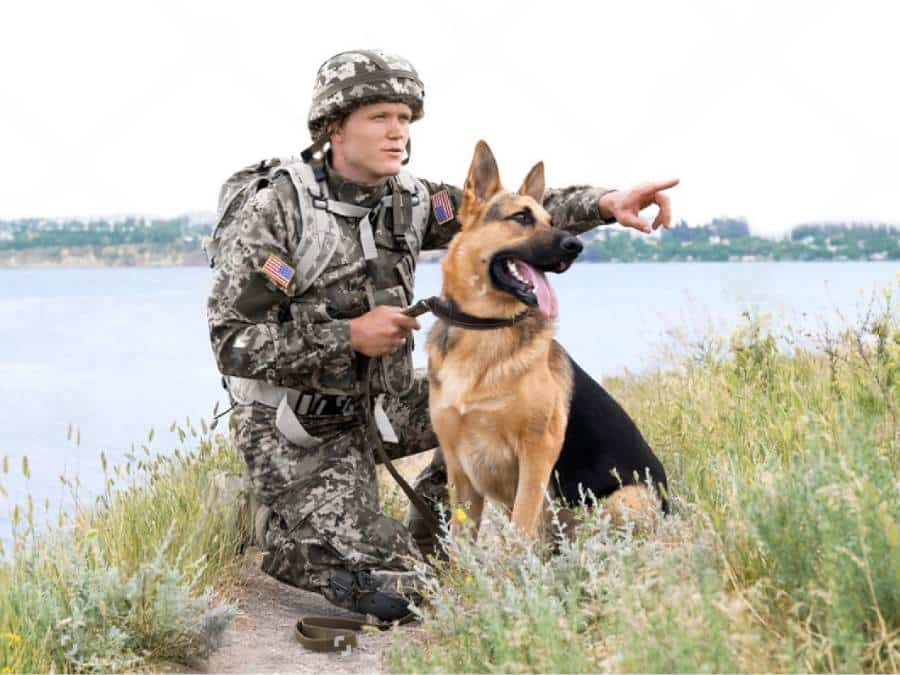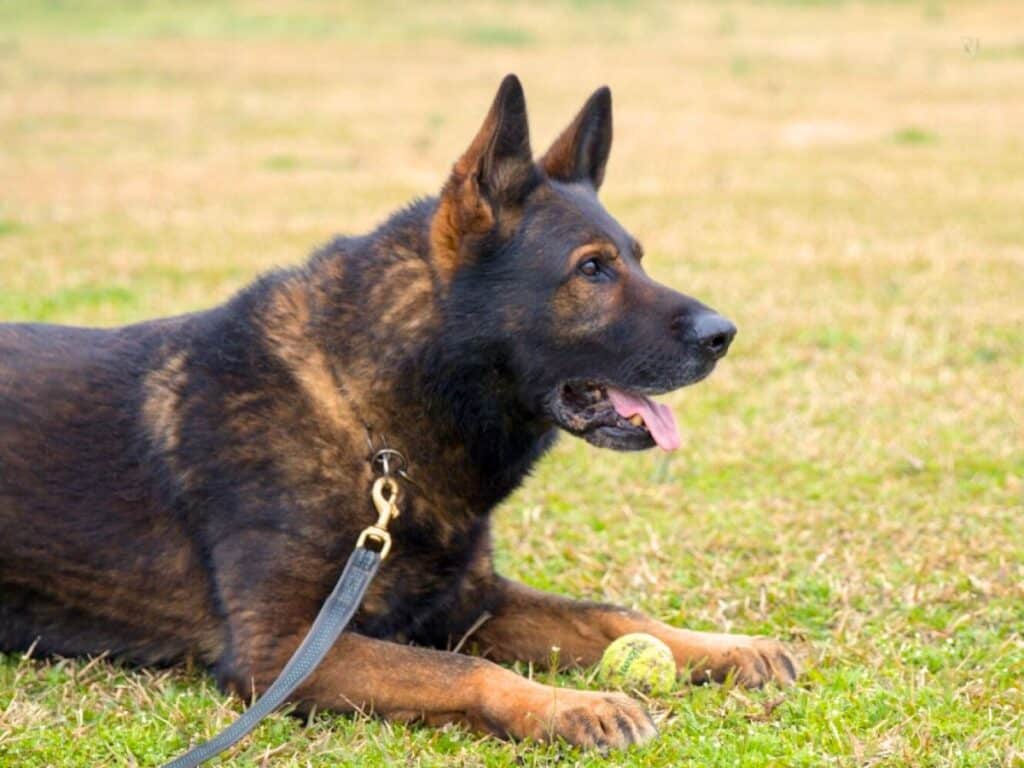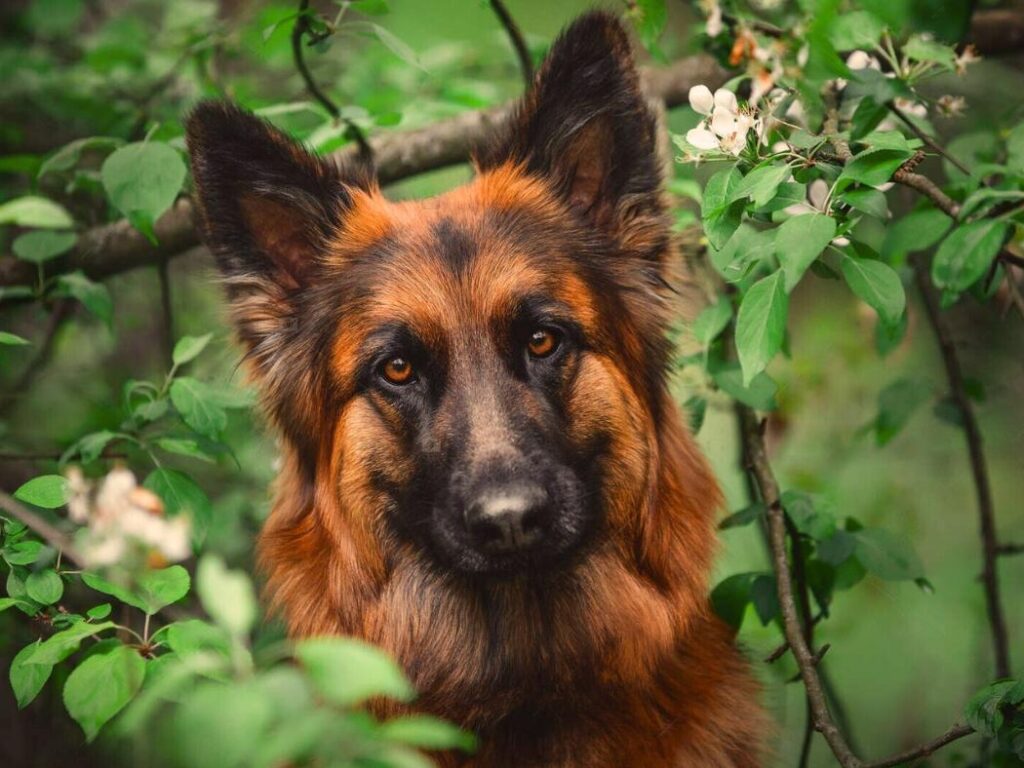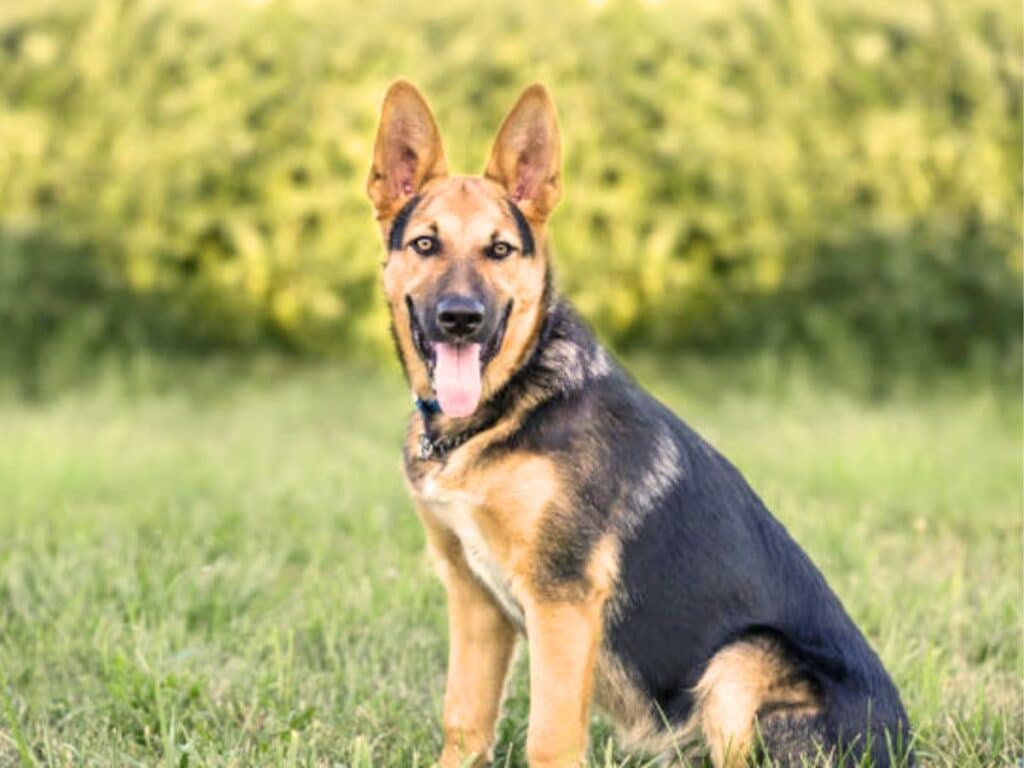German Shepherds have a long history of serving as military dogs. These highly intelligent and trainable dogs have proven to be invaluable assets in various tasks and operations.
From the battlefields of World War I to the contemporary landscapes of modern warfare, these remarkable dogs have stood shoulder-to-shoulder with their human counterparts, demonstrating an unparalleled commitment to service.
How Did German Shepherds Become Military Dogs?
Captain Max von Stephanitz of the German Army developed the German Shepherd Dog (GSD) between 1899 and 1914.
His goal was to create a working dog with traits like intelligence, loyalty, dedication, and tenacity, which are essential for military and police purposes.
Stephanitz spent many years selectively breeding these dogs to perfect their abilities.

To showcase the potential of this new breed, he lent them to German police departments, forming the first K9 Corps.
When the German police tested these new dogs, the GSDs showed a lot of promise in areas like trainability, tracking, and guarding.
Stephanitz saw the potential for these dogs to be useful in the German military as well. After the initial trials with the police, Stephanitz wanted to include German Shepherds in military units.
Fortunately for Stephanitz, the ending of the trials of his dogs with the police coincided with the beginning of World War 1.
RELATED: Why Are German Shepherds Police Dogs?
German Shepherd Military Dog History
German Shepherd’s career as the military working dogs began during World War I when they were first used by the German army. Originally, they were employed as messenger dogs but quickly proved their worth in more specialized roles.
World War I (1914 – 1918)
During World War I in 1914, the German Military enlisted German Shepherd Dogs to assist them in various roles both on the battlefield and within the German Army. (Source)

On the battlefield, they acted as sentries, messengers, and ammunition carriers. However, their true value was demonstrated in aiding wounded soldiers on the battlefield.

These intelligent and brave dogs led injured and blinded soldiers to safety and medical attention.
Many servicemen from different countries witnessed these dogs performing countless acts of bravery in incredibly stressful and dangerous situations.

The dogs’ remarkable abilities left such a lasting impression on the soldiers that, following the conflict, the Germans, Americans, and English all began to develop their own units of German Shepherd Dogs specifically for military purposes.
World War II (1939 – 1945)
The use of German Shepherds continued into World War II for both Axis and Allied forces.
In Germany, GSDs were utilized for mine detection, sentinel duty, guard work, messaging services, and other important tasks.
Meanwhile, the United States also deployed these dogs on the battlefield. They mainly served as messengers to help soldiers communicate effectively during combat situations. (Source)

German Shepherds acted as guards and search-and-rescue dogs during this war.
Their exceptional performance led to the establishment of numerous K-9 training camps where GSDs received regular training for military service.
During this period, Dogs for Defense was formed in America with a mission to provide thousands of trained dogs to support the army’s efforts during World War II.

The trained dogs from both Axis and Allied forces became a common sight wherever troops traveled around the world.
Role of German Shepherds as Military Dogs
German Shepherds are renowned for their high level of intelligence, which makes them easily trainable for complex tasks. Their ability to quickly comprehend and execute commands makes them ideal for military applications, where precision and reliability are paramount.
Here are some of the key roles that German Shepherds perform in military settings:
1. Reconnaissance and Detection
One of the primary roles of German Shepherds in the military is reconnaissance and detection. These dogs are trained to navigate challenging terrains, locate hidden or camouflaged enemies, and provide valuable information to their human counterparts.
Their acute sense of smell, hearing, and exceptional agility make them indispensable assets in covert operations.
2. Search and Rescue
German Shepherds are well-suited for search and rescue missions, especially in disaster-stricken areas or combat zones.
Their keen sense of smell allows them to locate survivors buried under rubble, and their agility enables them to traverse challenging landscapes.
Military search and rescue teams often rely on these dogs to save lives in critical situations.

3. Explosives Detection
The keen olfactory senses of German Shepherds make them exceptional in detecting explosives and other hazardous materials.
Trained to identify specific scents associated with explosives, these dogs are used to sweep areas for potential threats, ensuring the safety of military personnel and civilians alike.
4. Combat Support
German Shepherds have also proven their mettle as combat support animals. In some cases, they are trained to accompany infantry units, providing an added layer of protection and enhancing the overall effectiveness of military operations.
Their presence can boost morale among troops and act as a deterrent to potential threats.
5. Guard and Patrol Duties
Military installations, bases, and other secured facilities often have extensive perimeters that need to be monitored.
German Shepherds are well-suited for patrolling these areas, as they can cover large distances quickly and efficiently.
German Shepherds have excellent low-light vision, making them well-suited for patrolling during nighttime hours.
This is particularly valuable for military operations that require continuous surveillance and security, regardless of the time of day.
RELATED: Are German Shepherds Good Guard Dogs?
6. Casualty Evacuation
German Shepherds are trained to assist in the evacuation of wounded soldiers from a battlefield. They can provide support by pulling small carts or helping injured individuals move to safety.
7. Messenger Duties
In certain situations, German Shepherd military dogs have been used as messengers to deliver messages between military units. These dogs can be trained to carry small payloads and navigate through challenging environments.
Overall, German Shepherds are valued in military operations for their versatility, intelligence, and ability to perform a variety of tasks that contribute to the safety and security of military personnel and facilities.
While technology continues to advance, the unique skills and instincts of German Shepherd dogs makes them valuable assets in a variety of military roles.

Why Does the Military Use German Shepherds?
German Shepherds are commonly used by the military for various purposes due to their unique combination of traits that make them well-suited for specific tasks. Here are some reasons why the military often chooses German Shepherds:
1. Intelligence
German Shepherds are known for their high level of intelligence and trainability. This makes them ideal for learning and executing complex tasks, which is crucial in military operations.
2. Versatility
These dogs are versatile and can be trained for a variety of roles. They are used in roles such as patrol, detection, search and rescue, and even in specialized units like the military police.
3. Obedience
German Shepherds are known for their strong sense of loyalty and obedience to their handlers. This is essential in military situations where precise control over the dog is required.

4. Sensory Abilities
German Shepherds have excellent sensory abilities, including a keen sense of smell and hearing. This makes them well-suited for roles such as the detection of explosives, and drugs, or even locating missing persons.
5. Courage and Confidence
German Shepherds are naturally protective and exhibit courage and confidence. In military operations, these traits are crucial, especially in roles that involve apprehending suspects or working in potentially dangerous situations.
6. Physical Fitness
German Shepherds are strong and agile, making them capable of handling physically demanding tasks. They can navigate various terrains and endure strenuous activities, which is essential in military environments.

7. Adaptability
German Shepherds are adaptable to different environments and climates. This is important for military operations that may take place in diverse settings.
8. Deterrence
The presence of a German Shepherd can act as a deterrent. Their imposing size, along with their training, can discourage potential threats, providing a level of security to military personnel.
RELATED: Can a German Shepherd Kill You?
9. History of Service
German Shepherds have a long history of serving in various military and police forces around the world. Their impressive track record in these roles contributes to their continued use in military operations.
Overall, the combination of intelligence, versatility, loyalty, and physical attributes makes German Shepherds valuable assets in military applications, serving in roles that contribute to the safety and success of military operations.

Specialized Training for Military Service
1. Basic Training: Obedience, Commands, and Socialization
German Shepherds undergo rigorous training to prepare them for their roles in the military.
Basic obedience training includes teaching them essential commands such as sit, stay, lie down, and come. These commands are vital for maintaining control and ensuring the safety of both the dog and its handler in various situations.
In addition to obedience training, socialization plays a crucial role in preparing German Shepherds for military service.
They are exposed to different environments, people, and animals to ensure they remain calm and focused in any situation. This helps them adapt to new surroundings during deployments or missions.
2. Advanced Training: Detection, Search and Rescue, and Patrol
One important aspect of this phase of training is detection work.
These dogs are trained to sniff out explosives, drugs, or other contraband substances that may pose a threat. Their keen sense of smell allows them to locate hidden items with remarkable accuracy.
German Shepherds also receive specialized training in search and rescue operations. They learn how to track scents over long distances and locate missing persons or survivors in disaster-stricken areas.
Another crucial aspect of advanced training is patrol work. German Shepherds are taught how to apprehend suspects effectively while protecting their handlers from harm.
They learn techniques such as bite work and controlled aggression under strict supervision.
This enables them to assist military personnel in capturing dangerous individuals during combat or law enforcement operations.

3. Combat Training: Adapting to High-Stress Environments
German Shepherds undergo intense simulations and exercises to acclimate them to high-stress environments.
They are exposed to loud noises, gunfire, explosions, and other chaotic situations they may encounter in combat zones.
During combat training, German Shepherds learn how to remain focused and perform their duties despite the surrounding chaos.
German Shepherd War Heroes
Countless stories highlight the extraordinary feats German Shepherds have accomplished on the battlefield, showcasing their intelligence, agility, and dedication to their handlers.
Rifleman Khan
Rifleman Khan was a German Shepherd Dog who became a military dog during World War II. Lance Corporal James Muldoon became his handler.

In November 1944, during an intense battle, Khan and Muldoon were in an assault craft when the boat came under heavy fire.
The boat overturned and the soldiers were thrown into the water. Khan immediately swam towards the shore to search for Muldoon.
Sadly, Muldoon couldn’t swim. Despite the ongoing heavy shelling, Khan fearlessly swam back a distance of 200 yards to reach Muldoon and dragged him out of the water onto the safety of the shore. Exhausted from his heroic efforts, Khan eventually collapsed beside Muldoon.
Khan was awarded the Dickin Medal (the animal equivalent of the Victoria Cross) for bravery on 27 March 1945
Lucca
Another inspiring tale is that of Lucca, a highly skilled explosive detection dog who served in both Iraq and Afghanistan.

During her six-year career in the Marine Corps, Lucca completed over 400 missions without a single casualty or injury. Her keen sense of smell helped uncover countless hidden explosives, saving countless lives in the process.
In recognition of her exceptional service, Lucca also received the prestigious Dickin Medal.
Nemo
Nemo, a German Shepherd Air Force sentry dog who served in the Vietnam War in 1966 protected his handler Robert Throneburg during an attack on Tan Son Nut Air Base by the Viet Cong.

When the Air Base was hit by a mortar, it was Nemo’s job to find any intruders who infiltrated the base, and, upon finding a group hiding near the perimeter, he attacked with Throneburg close behind.
Throneburg and Nemo were injured in the incident, but Nemo was credited with his handler’s survival.
Retired German Shepherd Military Dogs
Retired German Shepherd military dogs go through a period of transition as they adapt to civilian life.
Many retired German Shepherd military dogs are placed in adoption programs where they can find loving homes.
The goal is to find families who understand the unique needs of these retired heroes and can provide them with the love and care they deserve.
Rehabilitation and Medical Care
Retirement often comes with its fair share of health issues for these brave dogs. Many retired German Shepherds require ongoing medical care, including treatment for injuries sustained during their time in service.
Rehabilitation programs are also available to help them regain strength and mobility if needed.

Second Careers
Some retired German Shepherd military dogs find second careers after leaving active duty.
Their skills and training make them excellent candidates for roles such as search and rescue dogs, therapy dogs, or even service dogs for individuals with disabilities.
These second careers allow them to continue serving and making a positive impact in their communities.
Conclusion
German Shepherd military dogs are incredible heroes who play vital roles in keeping us safe. From the pages of history to the present day, these dogs have shown us what it means to be brave, intelligent, and unconditionally devoted.
As we reflect on their stories of courage and sacrifice, let’s not forget their silent paws that have padded alongside soldiers through challenges and victories alike. Our salute extends beyond the battlefield to the trainers, handlers, and support teams who work tirelessly to ensure these canine warriors are at their best.
Frequently Asked Questions
1. Why are German Shepherds commonly used as military dogs?
German Shepherds are highly preferred in military roles due to their exceptional intelligence, agility, loyalty, and trainability. These qualities make them well-suited for various tasks such as detection, search and rescue, and guarding.
2. What specific training do German Shepherds undergo to become military dogs?
Military-trained German Shepherd dogs undergo rigorous training that includes obedience, agility, tracking, and protection exercises. They are also trained for specialized tasks such as bomb detection, patrolling, and apprehension.
3. Can any German Shepherd become a military dog, or are there specific criteria?
Not every German Shepherd is suitable for military work. Military dogs need to exhibit a strong temperament, high energy levels, and a willingness to work. Additionally, they should have a sound health history and pass specific evaluations to ensure they can handle the challenges of military tasks.
4. What happens to military dogs after their service is complete?
After their service, military dogs may be adopted by their handlers or by civilian families. In some cases, they are retired and live out their lives as family pets. Organizations like the Military Working Dog Adoptions work to find suitable homes for retired military dogs, ensuring they receive the care and love they deserve in their retirement years.
Also Read:




